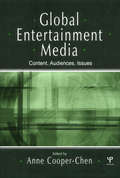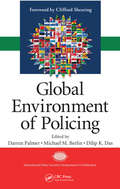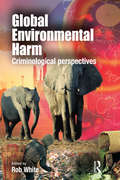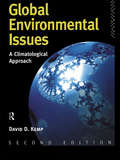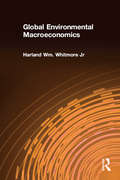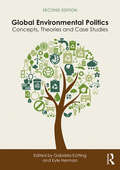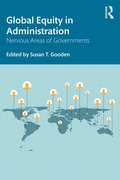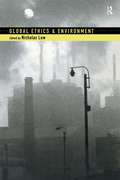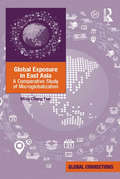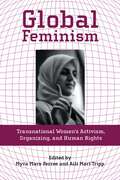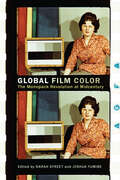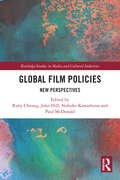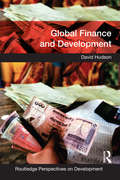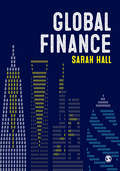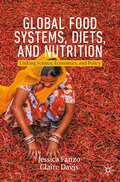- Table View
- List View
Global Entertainment Media: Content, Audiences, Issues (Routledge Communication Series)
by Anne Cooper-ChenGlobal Entertainment Media offers a unique perspective on entertainment media worldwide. As one of the first comprehensive books to address entertainment mass media worldwide, it addresses students as TV watchers and takes them to new places, both geographically and intellectually. Editor Anne Cooper-Chen has gathered an international group of scholars to explore such concepts as psychology, gratifications, and effects of media entertainment and its relation to national cultures, as well as to discuss the business of international TV trade by transnational media corporations.In this volume, experts discuss the content, audiences, and cultural and legal aspects of their respective countries, all of which are major TV markets. The country-specific chapters draw on the individual insights, expertise, and currency of 10 resident authors. Contributions represent every hemisphere of the globe, offering detailed examinations of media entertainment in United Kingdom, Germany, Egypt, Nigeria, South Africa, India, Japan, China, Brazil, and Mexico. The two concluding chapters provide cross-national case studies that look at familiar TV experiences--The Olympics and the "Who Wants to Be a Millionaire" show--in global and novel ways.Global Entertainment Media is intended for students in international media, comparative media, cross-cultural communication, and television studies, and it also has much to offer scholars and researchers in entertainment media.
Global Environment of Policing (International Police Executive Symposium Co-publications)
by Dilip K. Das Darren Palmer Michael M. BerlinPolice organizations across the globe are experiencing major changes. Many nations cope with funding constraints as pressures within their societies, terrorism and transnational crime, and social and political transformations necessitate a more democratic form of policing. Drawn from the proceedings at the International Police Executive Symposium i
Global Environmental Change: A Natural and Cultural Environmental History
by Antoinette MannionNow in its second edition. This text has been extensively revised and rewritten to reflect the growth in environmental research during the last decade. Human-induced environmental change is occurring at such a rapid rate that, inevitably, the fundamental processes involved in biogeochemical cycling are being altered. Global Environmental Change considers alterations to the biogeochemical cycles of carbon, nitrogen, sulphur and other elements as a result of industrial/technological development and agriculture, which have significantly altered the natural environment. The book adopts a temporal and spatial approach to environmental change, beginning with the natural environmental change of the Quaternery period and continuing with the culturally-induced change since the inception of agriculture 10,000 years ago.
Global Environmental Harm: Criminological Perspectives
by Rob WhiteThis book brings together original cutting edge work that deals with global environmental harm from a wide variety of geographical and critical perspectives. The topics covered in the book are global, regional and local in nature, although in each case there are clear transnational or global dimensions. The book explores topics that provide theoretical, methodological and substantive insights into the nature and dynamics of environmental harm, and the transference of this harm across regions, continents and globally. Specific topics include the criminal nature of global warming, an ethnographic study of pollution and consciousness of environmental harm, environmental destruction associated with huge industrial developments, chaos theory and environmental social justice, de-forestation as a global phenomenon, illegal trade in endangered species, and transference of toxicity. The collection as a whole reinforces the importance of eco-global criminology as a dynamic paradigm for theory and action on environmental issues in the 21st century. The criminological perspectives presented herein are important both in discerning the nature and complexities of global environmental harms and, ultimately, in forging responses to them.
Global Environmental Issues: A Climatological Approach
by David KempThis book provides a balanced account of the global environmental issues which threaten our society and which we neglect at our peril. Analysing both social and environmental components of the issues - global warming, ozone depletion, acid rain and drought - the book offers a valuable integrative approach and a detailed analysis of environmental issues in a clear, non-technical manner. Emphasising the climatological dimension common to all environmental issues, Global Environmental Issues recognises the multi-faceted nature of the issues, their common causes and the possibility of common solutions. Assessment of socio-economic, cultural amd political factors provides a balanced introduction to both the dangers and advantages of human interference with the environment. What have we done to deserve our current environmental crisis? Can we solve our current environmental problems, or is it too late?This new edition of a best selling text is completely updated and expands to include greater detail and new material such as a new section on atmospheric modelling. A glossary has been added together with a bibliography for further reading at the end of each chapter, allowing readers to develop their interest in specific areas. The interdisciplinary text will prove invaluable to students in geography, environmental studies and other courses in whcih the environmental approach is emphasised.
Global Environmental Macroeconomics
by Harland Wm. Whitmore JrPresents a dynamic, two-country model of the world economy, incorporating restrictions with respect to: the availability of nonrenewable resources; the ability of the global environment to assimilate pollutants; the ability of the ecosystem to replenish renewable resources; the productivity of real resources (e.g., labor) in pollution abatement. In addition, the book explores the interactions between and among the natural resource, labor, product, and financial markets.
Global Environmental Politics: Concepts, Theories and Case Studies
by Gabriela KüttingGlobal Environmental Politics is the perfect introduction to this increasingly significant area. The text combines an accessible introduction to the most important environmental theories and concepts with a series of detailed case studies of the most pressing environmental problems. Features and benefits of the book: Explains the most important concepts and theories in environmental politics. Introduces environmental politics within the context of political science and international relations theories. Demonstrates how the concepts and theories apply in a wide variety of real world contexts. Case studies include the most important environmental issues from climate change and biodiversity to forests and marine pollution. Each chapter is written by an established international authority in the field. ? This exciting new textbook is essential reading all students of environmental politics and will be of great interest to students of International Relations and Political Economy.
Global Environmental Politics: Concepts, Theories and Case Studies
by Gabriela Kütting Kyle HermanGlobal Environmental Politics is the perfect introduction to this increasingly significant area. This fully revised and updated new edition combines an accessible introduction to the most important environmental theories and concepts with a series of detailed case studies of the most pressing environmental problems. Features and benefits of the book: Explains the most important concepts and theories in environmental politics; Introduces environmental politics within the context of political science and international relations theories; Demonstrates how the concepts and theories apply in a wide variety of real world contexts; New case study chapters on the role of technology, the role of China, endangered species, biodiversity and the politics of conservation, the politics of food, forests, and the politics of waste; Each chapter is written by an established international authority in the field; Fully up to date with the latest topics such as climate change negotiations, transnational governance, new indicators for sustainable development goals and much more; More in-text support, such as end of chapter web links and discussion questions. This exciting textbook is essential reading for all students of environmental politics and will be of key interest to students of international relations and political economy.
Global Equity in Administration: Nervous Areas of Governments
by Susan T. GoodenGovernments around the world face the challenge of espousing principles of fairness but practicing inequity in their administration. Issues of equity and justice are fundamental concerns of government, and thus to public administrators, who constantly struggle to evaluate a country’s social climate and ensure equity in governance. Such evaluation is unlikely to occur in a serious way, however, if government actors are fundamentally too uncomfortable to directly engage the topic. The result, this book argues, is a context of 'nervousness,' which unless squarely acknowledged and addressed, can become debilitating and thwart progress toward achieving social equity. This volume explores and expands our understanding of the concept of nervousness in the administration of government services around the world, demonstrating the ways in which such an emotional and physical reaction can debilitate government actions that are needed to promote social equity and justice. Each of the chapters in this edited volume focuses on a single country and examines a specific nervous area of government, highlighting important historical and political considerations, as well as specific evidence of promising progress. It considers the complexity of nervous areas of governments around the world, while identifying encouraging approaches and initiatives. Global Equity in Administration is required reading for all practicing and aspiring public servants concerned with fair and equitable provision of public services around the world.
Global Ethics and Environment
by Nicholas LowAs global capitalism expands and reaches ever-further corners of the world, practical problems continue to escalate and repercussions become increasingly serious and irreversible. These practical problems carry with them equally important and ethical issues.Global Ethics and Environment explores these ethical issues from a range of perspectives and using a wide range of case studies. Chapters focus on: the impact of development in new industrial regions; the ethical relationship between human and non-human nature; the application of ethics in different cultural and institutional contexts; environmental injustice in the location of hazardous materials and processes; the ethics of the impact of a single event (Chernobyl) on the global community; the ethics of transitional institutions.This collection will both stimulate debate and provide an excellent resource for wide-ranging case study material and solid academic context.
Global Exposure in East Asia: A Comparative Study of Microglobalization (Global Connections)
by Ming-Chang TsaiIn contrast to speculative, sweeping literature on globalization Global Exposure in East Asia grounds globalization theories in a detailed empirical analysis, providing a systematic investigation of what until now have been grand narratives of huge global phenomena. This book presents a micro-level explanation of globalization by examining individual global exposure and its influence in the values and perceptions of individuals, contending that individual and personal global experience, or 'microglobalization', is a key variable in understanding how modern mobile persons act and think in ways different from those who remain geographically immobile and constrained. Drawing on detailed empirical evidence from China, Japan, Taiwan and South Korea, Global Exposure in East Asia explores the structures of global exposure and their influences on values and identities in contemporary East Asia. A rich, comparative and grounded examination of modern theories of globalization, this book introduces an innovative perspective that highlights the significance of microglobalization in understanding quotidian lives in a context of ever expanding transnational exchanges and connectivities. As such, it will appeal to social scientists with interests in globalization, cosmopolitanism, mobility, migration and transnationalism, (national) identity and everyday life.
Global Families: A History of Asian International Adoption in America (Nation of Nations #8)
by Catherine Ceniza ChoyIn the last fifty years, transnational adoption—specifically, the adoption of Asian children—has exploded in popularity as an alternative path to family making. Despite the cultural acceptance of this practice, surprisingly little attention has been paid to the factors that allowed Asian international adoption to flourish. In Global Families, Catherine Ceniza Choy unearths the little-known historical origins of Asian international adoption in the United States. Beginning with the post-World War II presence of the U.S. military in Asia, she reveals how mixed-race children born of Japanese, Korean, and Vietnamese women and U.S. servicemen comprised one of the earliest groups of adoptive children. Based on extensive archival research, Global Families moves beyond one-dimensional portrayals of Asian international adoption as either a progressive form of U.S. multiculturalism or as an exploitative form of cultural and economic imperialism. Rather, Choy acknowledges the complexity of the phenomenon, illuminating both its radical possibilities of a world united across national, cultural, and racial divides through family formation and its strong potential for reinforcing the very racial and cultural hierarchies it sought to challenge.
Global Feminism: Transnational Women's Activism, Organizing, and Human Rights
by Myra Marx Ferree Aili Mari TrippExplores the social and political developments that have energized movements of global feminismIncreasingly feminists around the world have successfully campaigned for recognition of women's full personhood and empowerment. Global Feminism explores the social and political developments that have energized this movement. Drawn from an international group of scholars and activists, the authors of these original essays assess both the opportunities that transnationalism has created and the tensions it has inadvertently fostered. By focusing on both the local and global struggles of today's feminist activists this important volume reveals much about women's changing rights, treatment and impact in the global world.Contributors: Melinda Adams, Aida Bagic, Yakin Ertürk, Myra Marx Ferree, Amy G. Mazur, Dorothy E. McBride, Hilkka Pietilä, Tetyana Pudrovska, Margaret Snyder, Sarah Swider, Aili Mari Tripp, Nira Yuval-Davis.
Global Filipinos: Migrants' Lives in the Virtual Village
by Deirdre McKayThe author of An Archipelago of Care documents the experiences of Filipino contract workers from the same village, traveling abroad for jobs.Contract workers from the Philippines make up one of the world’s largest movements of temporary labor migrants. Deirdre McKay follows Filipino migrants from one rural community to work sites overseas and then home again. Focusing on the experiences of individuals, McKay interrogates current approaches to globalization, multi-sited research, subjectivity, and the village itself. She shows that rather than weakening village ties, temporary labor migration gives the village a new global dimension created in and through the relationships, imaginations, and faith of its members in its potential as a site for a better future.“A unique and important study that adds a refreshing and necessary reminder that, on the most fundamental level, a village is part of the global world.” —Nicole Constable, author of Maid to Order in Hong Kong: Stories of Migrant Workers“A luminous, elegant, and well-argued multi-sited ethnographic study.” —Martin F. Manalansan IV, author of Global Divas: Filipino Gay Men in the Diaspora“The problems of overseas Filipino workers with loneliness; long absences from spouses, children, and other relatives; abuse by employers and governments; and efforts to use their time and talent to further individual opportunities are understood easily in McKay’s monograph. The photos of her Filipino informants . . . add a human touch to the topic of overseas workers. . . . Recommended.” —Choice
Global Film Color: The Monopack Revolution at Midcentury
by William Carroll Joshua Yumibe Philip Cavendish Kathryn Millard Sarah Street Laura Major Ranjani Mazumdar Stefan Soloman Kirsty Sinclair Dootson Kamalika Sanyal Heather Heckman Lydia Pappas Elena Gipponi Rafael de Luna Freire Josephine Diecke Linda Chen ZhangGlobal Film Color: The Monopack Revolution at Midcentury explores color filmmaking in a variety of countries and regions including India, China, Japan, and Russia, and across Europe and Africa. Most previous accounts of color film have concentrated on early 20th century color processes and Technicolor. Far less is known about the introduction and application of color technologies in the period from the mid-1940s to the 1980s, when photochemical, “monopack” color stocks came to dominate global film markets. As Eastmancolor, Agfacolor, Fujicolor and other film stocks became broadly available and affordable, national film industries increasingly converted to color, transforming the look and feel of global cinema. Covering a broad range of perspectives, the chapters explore themes such as transnational flows, knowledge exchange and transfer, the cyclical and asymmetrical circulation of technology in a global context, as well as the accompanying transformation of color film aesthetics in the postwar decades.
Global Film Policies: New Perspectives (Routledge Studies in Media and Cultural Industries)
by Ruby Cheung, John Hill, Nobuko Kawashima and Paul McDonaldGlobal Film Policies challenges conventional analyses of film policy as a stand-alone public policy confined within national boundaries and usually focused on supports for film production. The book argues for a more multi-faceted approach, extending beyond national boundaries and broadening its scope to recognise how other forms of policy pertain to film, including tax, labour, language and education.A team of experts in various areas of film and media studies critically analyse specific areas of film policy and engage with other public policy programmes, related concepts and/or phenomena. Each chapter brings together a general discussion of the conceptual and critical issues at stake, with specific references to particular territorial or historical contexts, institutions and policy initiatives that illuminate the more general issues. Case studies from different continents illustrate how film-related policies work with other public policies to maintain their influence not just on the film sector but also society more generally.This book will be an important resource for scholars and students studying global film policy in the areas of film, media or creative industries and business.
Global Finance and Development (Routledge Perspectives on Development)
by David HudsonThe question of money, how to provide it, and how to acquire it where needed is axiomatic to development. The realities of global poverty and the inequalities between the ‘haves’ and the ‘have-nots’ are clear and well documented, and the gaps between world’s richest and the world’s poorest are ever-increasing. But, even though funding development is assumed to be key, the relationship between finance and development is contested and complex. This book explores the variety of relationships between finance and development, offering a broad and critical understanding of these connections and perspectives. It breaks finance down into its various aspects, with separate chapters on aid, debt, equity, microfinance and remittances. Throughout the text, finance is presented as a double-edged sword: while it is a vital tool towards poverty reduction, helping to fund development, more critical approaches remind us of the ways in which finance can hinder development. It contains a range of case studies throughout to illustrate finance in practice, including, UK aid to India, debt in Zambia, Apple’s investment in China, microfinance in Mexico, government bond issues in Chile, and financial crisis in East Asia. The text develops and explores a number of themes throughout, such as the relationship between public and private sources of finance and debates about direct funding versus the allocation of credit through commercial financial markets. The book also explores finance and development interactions at various levels, from the global structure of finance through to local and everyday practices. Global Finance and Development offers a critical understanding of the nature of finance and development. This book encourages the reader to see financial processes as embedded within the broader structure of social relationships. Finance is defined and demonstrated to be money and credit, but also, crucially, the social relationships and institutions that enable the creation and distribution of credit and the consequences thereof. This valuable text is essential reading for all those concerned with poverty, inequality and development.
Global Finance on Screen: From Wall Street to Side Street
by Constantin ParvulescuGlobal Finance on Screen is the first collection exclusively dedicated to a growing body of multi-format and multimedia audiovisual work that this book designates as the finance film. Finance film provides critical visualizations of the secretive, elitist, PR firewalled, and gender and race-biased world of finance, and its mysterious characters, jargon and products. It reconstructs for the screen and for broader audiences finance’s logics, responsibilities, practices, and ethos, and traces the effects of money, markets, investment, credit, debt, bubbles, and crashes on our well-being, desires, values, and actions. The chapters for this interdisciplinary collection are written by European and North American scholars in film studies, anthropology, business ethics, cultural studies, political economy, and sociology. They reveal and evaluate the ability of film to document financial cultures; reflect economic, cultural and political transformations related to financialization; indicate the alienating and exploitative consequences of the growing role played by financial services in the global economy; mobilize social action against finance’s excesses; as well as spread finance and capitalist mythology. The collection offers in-depth investigations of feature films such as Wall Street, Freefall, Margin Call, Justice&Co, The Wolf of Wall Street, and The Big Short, and documentaries such as Inside Job, Capitalism: A Love Story and In a Strange Land.
Global Finance: Places, Spaces and People
by Sarah HallThe financial crisis of 2007–8 and its aftermath have resulted in the role of money and finance within the global economy becoming the subject of considerable debate in public, policy and media circles. Global Finance is a timely look at the contemporary international financial environment, providing an introduction to this dynamic field of research for students and more advanced researchers. Drawing on economic geography, economic sociology and critical management, Hall offers a broad selection of case studies that ground critical theory in our current financial climate. Hall examines and reviews a wide range of critical approaches relating to the role of money and finance in the global economy, dividing these approaches into three key sections: Global finance and international financial centres. Global finance and the ‘real’ economy’. Global financial subjects and actors. The book takes a uniquely interdisciplinary approach which, combined with an international spread of case studies, makes this book highly valuable to a wide range of upper level undergraduate courses across the social sciences.
Global Finance: Places, Spaces and People
by Sarah HallThe financial crisis of 2007–8 and its aftermath have resulted in the role of money and finance within the global economy becoming the subject of considerable debate in public, policy and media circles. Global Finance is a timely look at the contemporary international financial environment, providing an introduction to this dynamic field of research for students and more advanced researchers. Drawing on economic geography, economic sociology and critical management, Hall offers a broad selection of case studies that ground critical theory in our current financial climate. Hall examines and reviews a wide range of critical approaches relating to the role of money and finance in the global economy, dividing these approaches into three key sections: Global finance and international financial centres. Global finance and the ‘real’ economy’. Global financial subjects and actors. The book takes a uniquely interdisciplinary approach which, combined with an international spread of case studies, makes this book highly valuable to a wide range of upper level undergraduate courses across the social sciences.
Global Financial Crime: Terrorism, Money Laundering and Offshore Centres (Global Finance)
by Donato MasciandaroThe scope for financial crime has widened with the expansion and increased integration of financial markets. Money laundering, terrorism financing and tax crime have all changed in both nature and dimension. As new technologies reduce the importance of physical proximity to major onshore financial centres so a new generation of Offshore Financial Centres (OFCs) have emerged. This accessible volume provides a deeper analysis of the economic, institutional and political features of the OFCs, in order to design the optimal international regulatory policy. Using a multidisciplinary approach with an international level of expertise, the book evaluates international policies regarding offshore countries on the basis of a systematic analysis of their characteristics.
Global Fluids: The Cultural Politics of Reproductive Waste and Value (Fertility, Reproduction and Sexuality: Social and Cultural Perspectives #39)
by Charlotte KroløkkeIn the fertility and cosmetics industries, women’s body products – such as urine, eggs, and placentas – have moved from being seen as waste to becoming valuable ingredients. Taking a sociological and anthropological perspective, the author focuses in particular on the role that countries like Denmark, Spain, the Netherlands, and Japan play in the reproductive products industry, and discusses the moral limits of the cultural and rhetorical trajectories that turn women’s body products into internationally mobile substances.
Global Food Systems, Diets, and Nutrition: Linking Science, Economics, and Policy (Palgrave Studies in Agricultural Economics and Food Policy)
by Claire Davis Jessica FanzoEnsuring optimal diets and nutrition for the global population is a grand challenge fraught with many contentious issues. To achieve food security for all and protect health, we need functional, equitable, and sustainable food systems. Food systems are highly complex networks of individuals and institutions that depend on governance and policy leadership. This book explains how interconnected food systems and policies affect diets and nutrition in high-, middle-, and low-income countries. In tandem with food policy, food systems determine the availability, affordability, and nutritional quality of the food supply, which influences the diets that people are willing and able to consume. Readers will become familiar with both domestic and international food policy processes and actors, and they will be able to critically analyze and debate how policy and science affect diet and nutrition outcomes.
Global Foodscapes: Oppression and resistance in the life of food
by Alistair FraserWhat we eat – as well as how it is produced, processed, moved, sold, and used by our bodies seems to matter like never before. Global Foodscapes takes on this topicality and asks readers to think about how we are all involved in the making of an odd and, in many ways, troubling and contested food economy. It explores how food is conceived, traded, grown, reared, processed, sold, and consumed; investigates what goes wrong along the way; and assesses what diverse people around the world are doing to fix these faults. The text uses a carefully-crafted framework that explores the interaction of five forms of oppression and five means of resistance as they are worked out over five stages in the food economy. It draws on case studies from around the world that illuminate key issues about food in today's world; examines how oppression affects diverse people caught up in the food economy; and highlights how individuals, groups, and institutions such as governments, but also firms, are trying to improve how we interact with the food system. Global Foodscapes is a highly accessible and useful text for undergraduate students interested in the global food economy. The global range of case studies, examples, and reference points, as well as its original framework allows the text to speak to diverse audiences and generate debate about whether anything – and if so, what – needs to be done about the food system we depend upon so heavily. Additional materials such as suggested readings and discussion points help students consider the issues at hand and conduct initial and more detailed research on today's food economy.
Global Forest Governance and Climate Change: Interrogating Representation, Participation, And Decentralization (Palgrave Studies In Natural Resource Management Ser.)
by Emmanuel O. NuesiriThis edited collection assesses governance in forestry programmes and projects, including REDD+ governance. It examines political representation, participation and decentralisation in forest governance, providing insight as to how forest governance arrangements can be responsive to the socio-economic interests of local people and communities who live adjacent to and depend on forests.Global Forest Governance and Climate Change argues that inclusive complementary representation of local communities is required for strong participatory processes and democratic decentralisation of forest governance. Responsiveness to local people’s socio-economic interests in forestry initiatives require paying attention to not just the hosting of participatory meetings and activities, but also to the full cast of appointed, self-authorized, and elected representative agents that stand, speak, and act for local people. This book will be of interest to students and academics across the fields of climate change governance, forestry, development studies, and political economy. It will also be a useful resource for policy makers and practitioners responsible for forestry and climate change initiatives.
